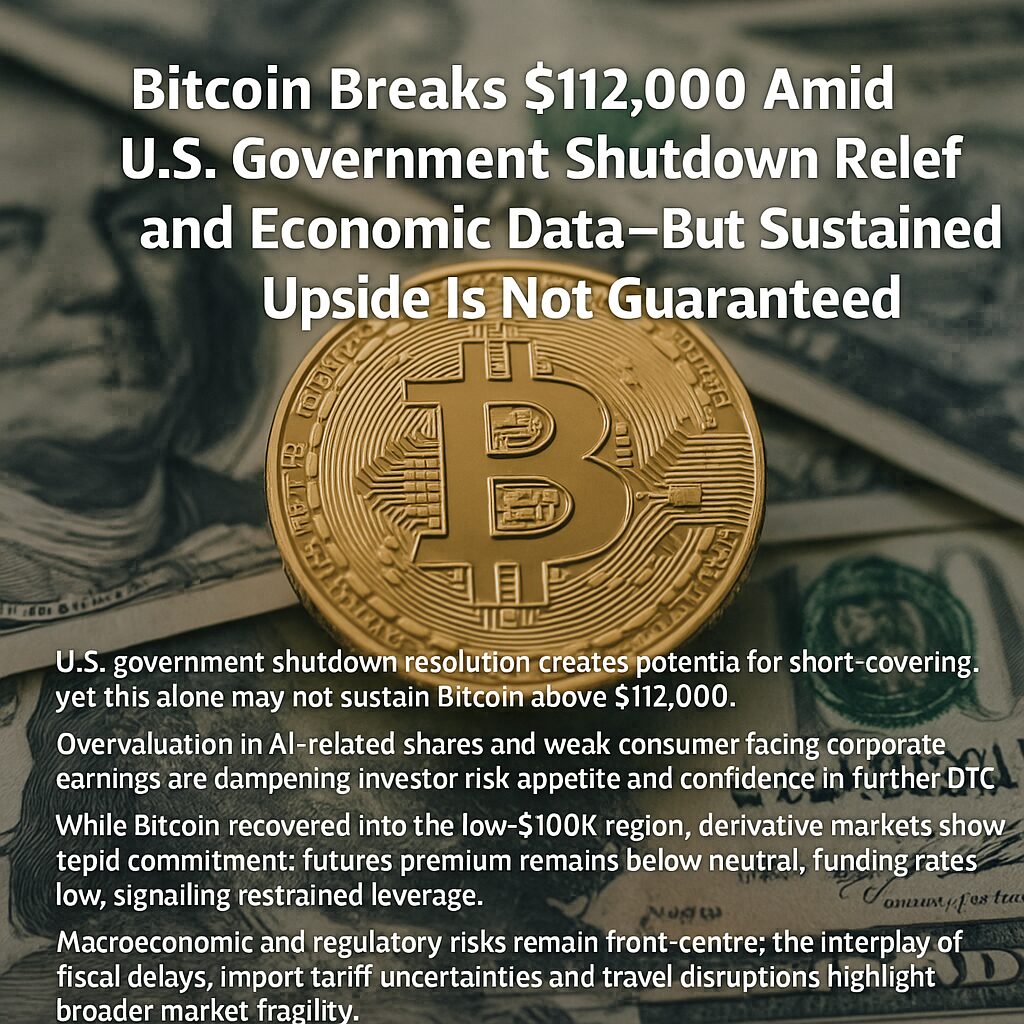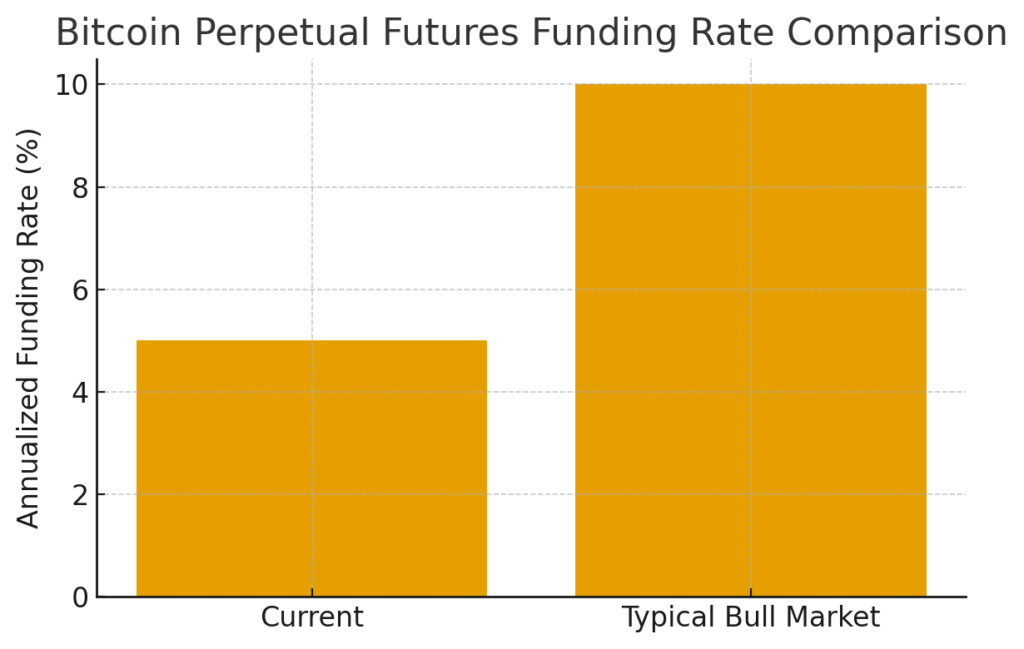
Main Points :
- U.S. government shutdown resolution creates potential for short-covering, yet this alone may not sustain Bitcoin above $112,000.
- Overvaluation in AI-related shares and weak consumer-facing corporate earnings are dampening investor risk appetite and confidence in further BTC upside.
- While Bitcoin recovered into the low-$100K region, derivative markets show tepid commitment; futures premium remains below neutral, funding rates low, signalling restrained leverage.
- Macroeconomic and regulatory risks remain front-and-centre: the interplay of fiscal delays, import tariff uncertainties and travel disruptions highlight broader market fragility.
- For crypto investors seeking fresh yield or new asset opportunities, altcoin flows, staking narratives and presale projects may become more relevant than relying solely on Bitcoin’s near-term breakout.
1. Context: Government Shutdown Relief and Bitcoin Reaction

In the U.S., when the possibility of a government shutdown looms or recedes, markets pay attention. The belief that the shutdown may be ending triggered relief across risk assets. Bitcoin, riding that wave, vaulted back into the $106,000 range after falling below earlier. The rationale: reduced fiscal paralysis implies fewer headwinds to consumer demand, which in turn bolsters growth expectations. At the same time, the short-positions in Bitcoin may have been squeezed, contributing to the move above $112,000.
However, it is important to emphasise that while this catalyst provided momentum, it does not guarantee a sustained breakout. The structural fundamentals inside the crypto market remain cautious. The shutdown relief is a macro event; crypto requires stronger micro conviction.
2. Technical Signals and Derivative Market Readings
While spot price has moved up, the derivative market tells a more nuanced story. For example, the two-month annualised futures premium for Bitcoin is trading at around 4 %, below the commonly referenced neutral level of 5 %. This suggests that the “carry” or cost of going long futures is not rich, which implies limited appetite for committed leverage.
Moreover, the perpetual futures annualised funding rate is around 5 %, which—while not deeply negative—also indicates that retail traders are not piling in with massive long positions. In a high-conviction bull market, one tends to see elevated funding rates and strong open interest expansions. At present, those signals are muted.

Thus, while the price broke above $112,000, the underlying leverage and sentiment metrics suggest that many traders remain on the sidelines, awaiting clearer confirmation rather than diving in.

3. Macro & Regulatory Risk Factors
Beyond crypto-specific measures, the broader environment remains fraught. The U.S. government shutdown had already caused thousands of flight cancellations, and the uncertainty around import-tariff authority (e.g., the U.S. Supreme Court questioning the executive’s tariff powers) adds an additional risk dimension.
For Bitcoin and the crypto market more broadly, this means that the asset class is still exposed to macroeconomic fragility—especially if consumer spending weakens or regulatory policy shifts unexpectedly. As noted, tension between fiscal delays and revenue shortfalls may offer temporary support to the economy, but the broader structural weakness persists.
Thus, for those looking for the “next cryptocurrency” or yield opportunity, it may be wise to also monitor projects that sit somewhat outside the Bitcoin macro-bet, especially those with strong utility, staking mechanics or upcoming events (halvings, network rewards, presales).
4. Altcoins, Presales and Emerging Opportunities
While Bitcoin hogs headlines, recent data suggest that altcoins are starting to attract more attention—especially tokens with staking programs or events built around them. For instance, the “altcoin season” indicator recently rose from 23 to 34 out of 100, signalling broader momentum beyond Bitcoin. Protocols like XRP, SUI and ZEC are seeing strong flows, and presale projects are gaining traction from investors hungry for the “next big thing”.
This dynamic may matter especially for our target audience: those seeking new crypto assets, alternative income sources and practical blockchain applications. While Bitcoin remains the anchor, yield-oriented or event-driven tokens may provide more asymmetrical upside in the current phase of market consolidation.
5. Investor Psychology and the Path Forward
Investor sentiment remains cautious. The options market for Bitcoin shows the put-call skew dropping to around 6 %—which is lower than typical levels during major downside fear events. That suggests that hedging and outright bearish bets have somewhat receded, but neither has unbridled optimism returned.
In practical terms, this means that the next leg for Bitcoin (and perhaps the broader crypto market) may require a fresh trigger—whether a major regulatory breakthrough, a tectonic adoption moment (such as a large institutional treasury allocation) or a macro shock (either positive or negative) that forces repositioning.
From the perspective of someone scanning for new opportunities: it may pay to keep an eye on tokens with upcoming catalyst events and networks with active staking or utility updates. Meanwhile, maintaining risk discipline around Bitcoin exposure is sensible given the mix of upside potential and structural friction.
Conclusion
In sum, Bitcoin’s climb above $112,000 is a noteworthy technical and psychological milestone—but one built on macro relief rather than crypto-specific strength alone. For investors focused on discovering new crypto assets and seeking alternative income or utility plays, the current environment suggests a slightly broader lens may be beneficial: monitor altcoins with strong narratives, upcoming presales, staking opportunities and network-driven catalysts. Bitcoin remains central—but the next wave of returns might come from beyond the flagship coin as sentiment, leverage and adoption recalibrate.

